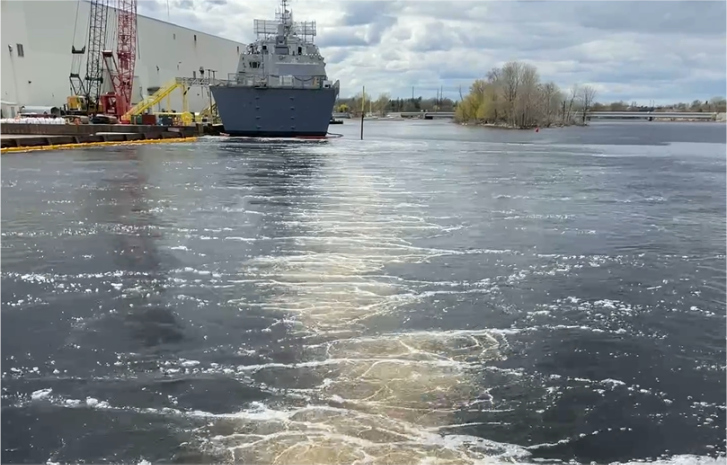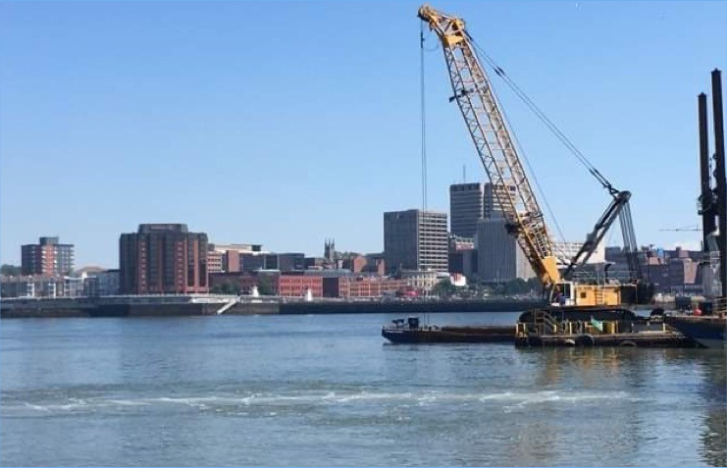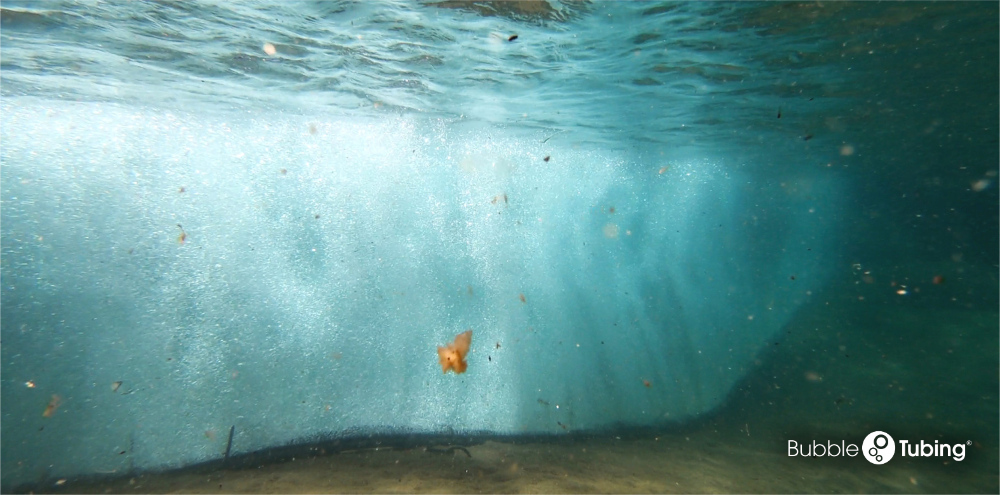Bubble Curtain for Sound Attenuation in River Tyne, UK
Marine wildlife protection during pile driving
A major construction project on the Tyne River has begun on the Holborn South Shields site in 2022 where a river wall was to be built. The construction of this wall required piling works in the water. For the drilling work, standards had to be met to protect marine organisms from excessive sound waves, particularly North Atlantic salmon that migrate at the time of the marine work. This particular species reacts to higher frequencies.
This award-winning project was the first of its kind in the UK for sound attenuation and was delivered through our UK distributor, Frog Environmental. For more information award-winning project on the use of our innovative technology, visit our UK distributor Frog Environmental’s website: Click Here
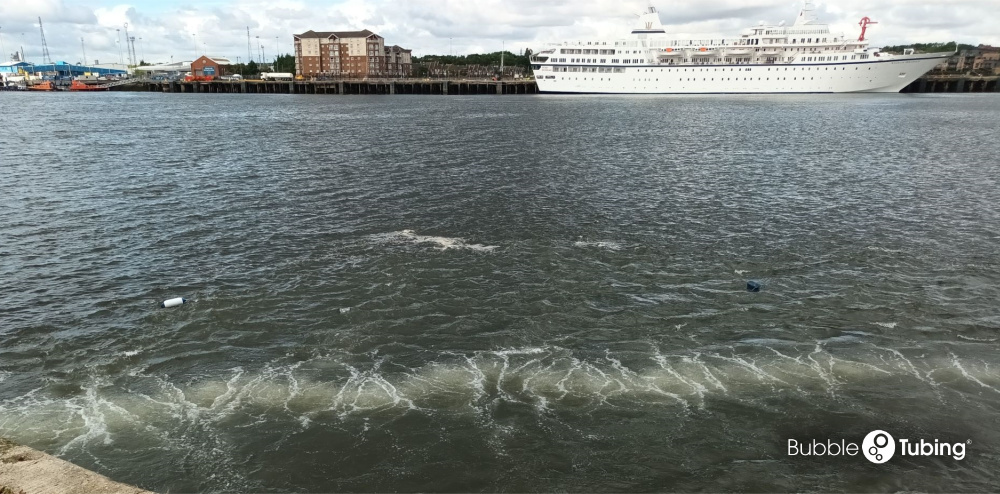
How does a bubble curtain work?
The use of Bubble Tubing® industrial air diffusers immersed in water creates an efficient bubble curtain which buffers and acts as a sound and pressure barrier. Bubble curtains can attenuate the transmission and intensity of underwater noise comparatively to how earmuffs would protect hearing from loud noises. Strategically positioned, these bubble curtains can attenuate various shock waves that are created by underwater activity such as pile driving, dredging, underwater explosions, rock blasting or drilling for oil exploration. Bubble curtains allow the free passage of vessels during construction and prevent marine wildlife from becoming trapped inside a closed construction site enabling them to leave the area towards a safe zone, even at the last minute. Bubble curtains are a sensible solution for protecting the marine environment. Click here to read more on this subject
Product Sold:
- Custom bubble curtain systems using 1 inch I.D. Bubble Tubing®.
- Bubble Tubing® (1 double curtain).
- Torpedo self sinking airline feeder hose.
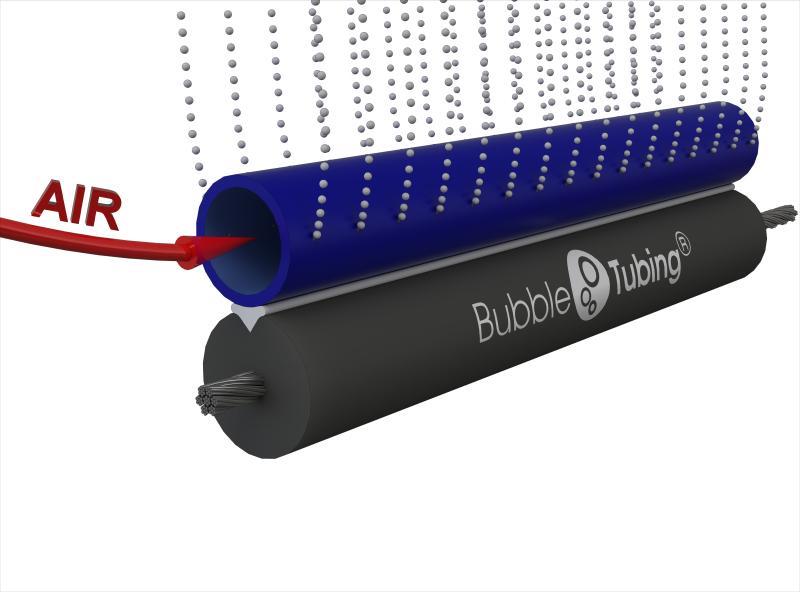
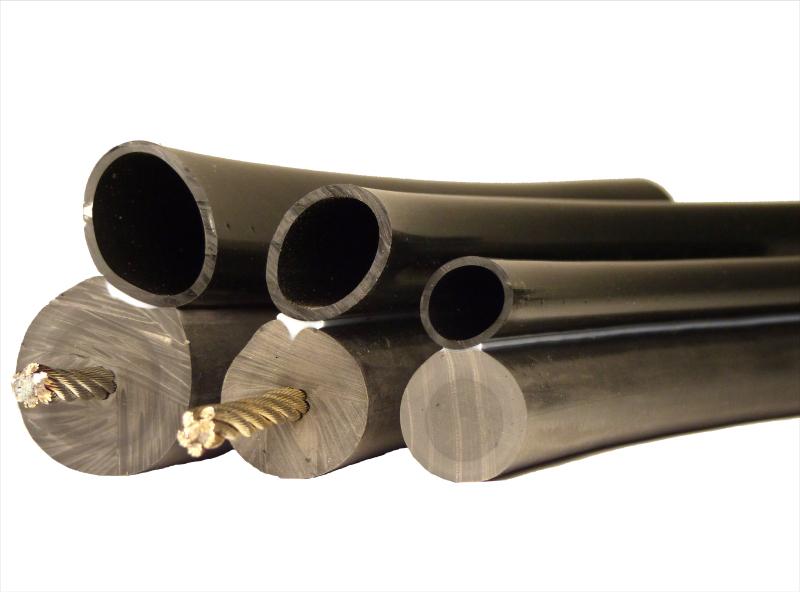
Exclusive to CanadianPond.ca Products Ltd., Bubble Tubing® is a linear air diffuser for aeration, de-icing and bubble curtain applications. It is designed and manufactured in Canada based on our specifications.
Bubble Tubing® diffusers produces many fine air bubbles ranging between 1 mm and 10 mm in diameter. A uniform stream of bubbles rise steadily from the bottom of waterways and canals, ponds, lakes, or lagoons to create a bubble barrier.
Compressed air enters the tubing, creating an inner pressure. The air is released through perforations found along both sides of the entire length of tubing. The ensuing bubbles are efficient in preventing clogging and fouling (typically found in porous diffusers), for the entire length of tubing. The released air forms a bubble curtain of uniforms and evenly dispersed fine bubbles.
R&D Validations:
Canadian Pond.ca Products Ltd. invested in a third party test study performed by GKM Consultants to prove the efficacy of a bubble curtain (Bubble Tubing®) for sound attenuation. This study was conducted in the Bedford Basin back in 2018 in Nova Scotia, Canada. During this study, it was well demonstrated that the use of a bubble curtain can reduce up to 80 dB of the sound travelling in water. The bubble curtain is effective at reducing all spectrum of frequencies. The bubble curtain was able to attenuate low-frequency sound by up to 35 dB, mid-frequency sound by up to 55 dB and high-frequency sound by up to 90 dB.
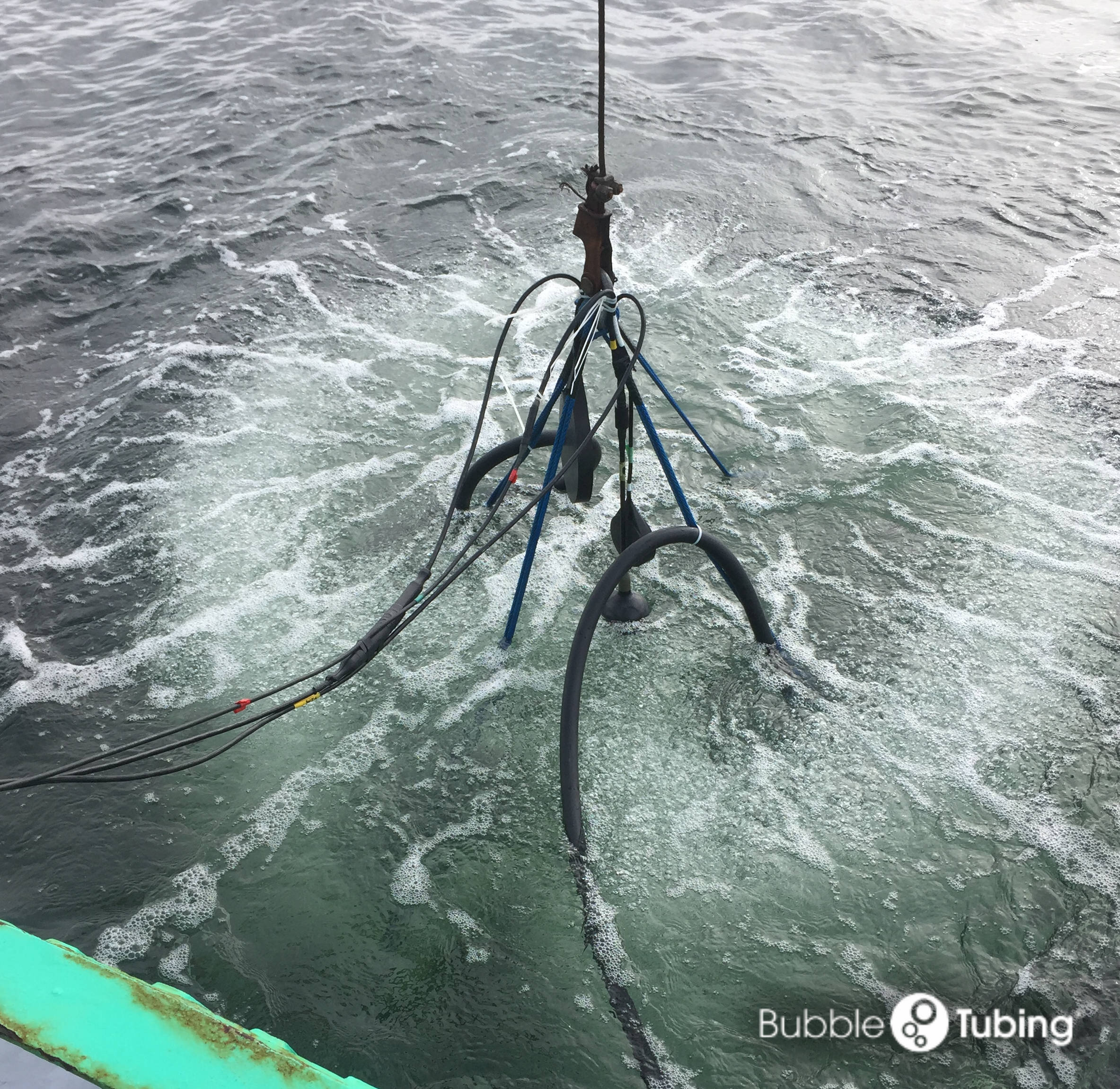
Installation:
Product, design and technical support was provided by Frog Environmental, our UK distributor with input from our engineers.
John F Hunt Regeneration, the contractor in charge of the project including the installation of the bubble curtain, installed the Bubble Tubing® for the first round of pile driving in 2022 and later for the second round of pile driving in 2023. As a contractor who respects environmental regulations, they are excited to add another tool to their tool box and will definitely use Bubble Tubing® bubble curtains for future projects.
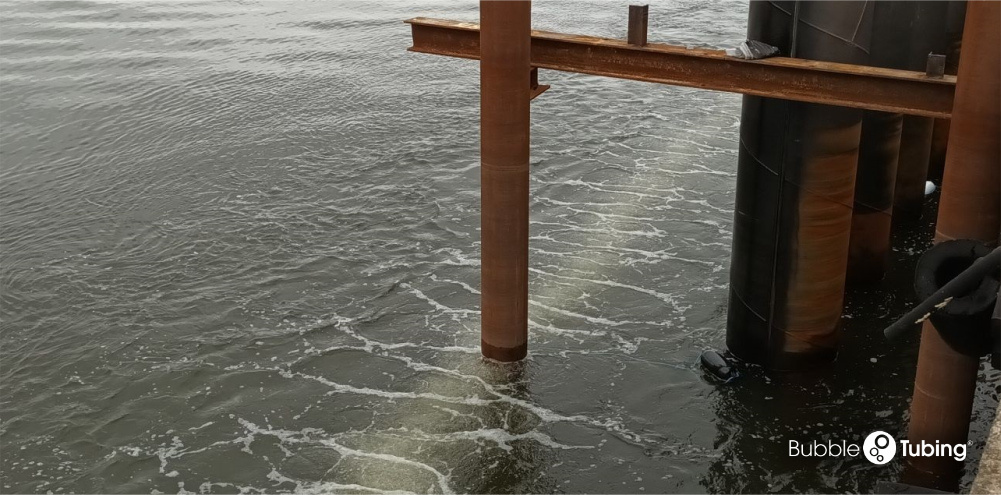
Sound Monitoring:
John F Hunt Regeneration hired Subacoustech Environmental Limited to monitor the impact piling noise level before and during the construction work.
Using the Reson TC4014 hydrophone, they measured the sound level prior to operations in order to have a base sound level data of this canal. The base sound level was between 100 and 140 dB which is consistent with similar canals in the UK as per Subacoustech Environmental Ltd. experience. (as per the Subacoustech Environmental Ltd. Report: Underwater Noise Monitoring or works at Holborn Docks on the River Tyne. October 2022)
For comparison purposes two other readings were recorded while the piling work was in progress. The first sound reading was taken prior to operating the bubble curtain. The second reading was taken while the bubble curtain was operational.
In Conclusion
The restriction regarding this species was: No pile driving 3 hours after low tides and 4 hours after high tides. A total of 7 hours every day where John F Hunt Regeneration would not be able to do pile driving. Typically, a day of piling work cost between 1 200 £ ($ 2060 CAD) and 1 500£ ($ 2573 CAD). Having this bubble curtain allowed the contractor to proceed with the piling work without any restriction on hours, saving on time and costs had the bubble curtain not been installed.
The bubble curtain reduced the sound impact of piling by over 20 dB from 163 dB to 140 dB at 750 metres from the pile. This noise reduction brings the sound level to its base line using the bubble curtain maintaining safe conditions for marine wildlife outside of the curtain. (as per the Subacoustech Environmental Ltd. Report: Underwater Noise Monitoring or works at Holborn Docks on the River Tyne. October 2022)
Sounds travel through water differently than through air. In water, a sound wave creates a pressure, and that pressure can be harmful to marine life. By limiting the sound from travelling means that it reduces the pressure it creates. A 20 dB sound reduction also means a pressure reduction equals to 90% in water1. This is a significant reduction making the aquatic life safer during marine construction work while using a bubble curtain using Bubble Tubing® Technology.
As demands for maritime construction grow, important laws and regulations such as those put in place by the MMO (Marine Management Organisation)vi of England, to protect sensitive or endangered species such as North Atlantic Salmon are necessary. Bubble Tubing® bubble curtains offer contractors the necessary tools to respect restrictions through effective sound attenuation strategies. Regulations pertaining to sound attenuation are more common around the globe for sub-sea operations. Requirements for mitigation measures for sound attenuation range between 5 dB to 20 dB from what we have encountered. Those targets vary depending on species to protect and regions.
Recognition:
Being the first bubble curtain for sound attenuation in the UK ever installed, this case received a lot of attention as a new technology innovation. Recognition received so far:
1- March 2023: The Magazine New Civil Engineer made an article on this case explaining this technology to the engineering sector in the UK. Click here to read the article
2- June 2023: Frog Environmental received the Innovation Showcase award during Seawork Marine Civil tradeshow in June 2023.
3- September 2023: Bubble Tubing® technology was short listed for the 2023 CN Specialists Awards in London. This event regroups specialist contractors from across the UK.
4- November 2023: Frog Environmental in combination with John F Hunt Regeneration won the Green Apple Awards for Buildings and Constructions by the Green Organisation. This organization is an international, independent, non-profit, non-political, environmental group, dedicated to recognizing, rewarding and promoting environmental best practice around the world.

Do you have an project ? Contact us, it will be our pleasure to help you in the development of your project.
Bubble Tubing® is a trademark owned by Canadianpond.ca Products Limited.
